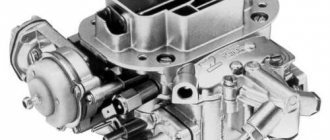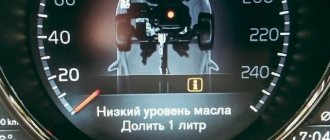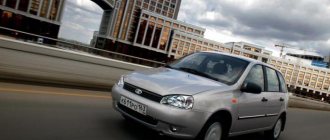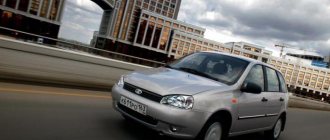The time is long gone when a car in a family was considered a luxury item. Many people have to travel many kilometers to their workplace, so a car becomes a necessary thing in the family. A large number of car owners use domestically produced cars. Among them, one of the popular ones is the VAZ 2110, which replaced the beloved VAZ “classic”.
When planning to purchase this car for personal use, the potential buyer is interested in the “appetite” of this car. According to test data, the average fuel consumption of the VAZ 2110 ranges from 5.5 to 10 liters per hundred kilometers. These indicators depend on many factors and may change in one direction or another, so they should serve as a guide for VAZ 2110 car owners.
Technical data
Content
It differs in all respects from other models with its improved engine system. According to its parameters, which undoubtedly affect gasoline consumption. VAZ 2110 for 100 km with a 1.5 liter engine and having 71 horsepower, it also has a carburetor power system and a 5-speed manual transmission. With such indicators, its maximum speed is 165 km/h, and its acceleration occurs in 14 seconds to 100 km/h.
| Engine | Consumption (highway) | Consumption (city) | Consumption (mixed cycle) |
| 1.5 (72 l. petrol) 5-mech | 5.5 l/100 km | 9.1 l/100 km | 7.6 l/100 km |
| 1.5i (79 hp petrol) 5-mech | 5.3 l/100 km | 8.6 l/100 km | 7.2 l/100 km |
| 1.6 (80 hp petrol) 5-mech | 6 l/100 km | 10 l/100 km | 7.5 l/100 km |
| 1.6i (89 hp, 131 Nm, petrol) 5-mech | 6.3 l/100 km | 10.1 l/100 km | 7.7 l/100 km |
| 1.5i (92 hp, petrol) 5-mech | 7.1 l/100 km | 9.5 l/100 km | 8.1 l/100 km |
Increased fuel costs
High fuel consumption of VAZ 2110 occurs due to several reasons
:
- Poor quality gasoline.
- Aggressive driving style.
- Failures in engine systems.
Winter driving also affects the fuel consumption of the VAZ 2110 per 100 km, since it is necessary to warm up not only the engine, but also the interior of the car.
This results in additional costs.
The technical indicators of all car systems affect the fuel consumption of the VAZ 2110. Therefore, you need to regularly diagnose your car so that no problems arise while driving.
Fuel consumption per 100 km for VAZ 2110
All VAZ 2110 models have similar configurations and the same gasoline consumption. On the highway, fuel consumption per 100 km of the VAZ 2110 is 5.5 liters, with a combined cycle no more than 7.6 liters. But if we compare driving a car within the city, the gasoline consumption per 100 km of a VAZ 2110 will be no more than 9.1 liters. In winter, these figures increase to 2 liters.
But the owners of these cars claim that the real fuel consumption for 100 km is as follows:
- City - up to 12 l.
- The route is up to 8 l.
- Mixed cycle - 9 l.
The manufacturer's table shows fuel consumption figures at idle speed; in reality, they are no different from true gasoline consumption; they amount to approximately 1 liter of liquid fuel.
Owner reviews
- Stepan, Kaluga. I needed a car for business trips. The choice fell on the VAZ 21102, which was chosen on the automobile market. Outwardly it looked quite decent with a mileage of just over 80 thousand km. I was especially concerned about fuel consumption, since I had to cover 100 km or more every day. If I moved around the city, the engine burned within 10 liters per hundred km. When traveling to other populated areas along the highway, it did not exceed 6 liters per 100 km. I service the car myself.
- Sergey, Vitebsk. I bought a VAZ 2110 because I have a weakness for AVTOVAZ products. A car with a 9 engine, volume 1.5 liters, 8 valves in the head. I don’t like to drive recklessly, so the engine power is enough for me. For the VAZ 2110, fuel consumption per 100 km suits me; the average figure is within 7.5 liters. Once I had to travel more than 1000 km on vacation; calculating the gasoline consumed showed a figure of 6.5 liters per hundred kilometers. Gasoline consumption was monitored by liters of fuel filled and total mileage.
- Vladimir, Podolsk. I was looking for a car to work in a taxi service. There weren’t enough funds to purchase a foreign car, so I opted for the relatively new VAZ 2110. I took the car second-hand, so the first question to the seller was about the fuel consumption of the VAZ 2110. According to the seller, the average figure was around 7 liters. The engine is 16-valve, the condition today with a mileage of more than 160 thousand km is satisfactory. I recently cleaned the injector, after which, according to indirect sensations, the gasoline consumption has become less.
- Nikolay from Smolensk. I bought a new ten at a car dealership. According to the seller, the VAZ of the tenth family has gasoline consumption figures close to those of foreign-made cars. In fact, his words were confirmed. The engine of my ten has a volume of 1.6 liters, 16 valves in the head. There is enough engine power on the highway, but when accelerating sharply I would like to have a little more. The gasoline consumption in the city is upsetting, sometimes exceeding 10 liters per 100 km. I blame my driving style. As for the costs of the Lada 2110, fuel accounts for the most. The cost of spare parts and service is reasonable.
- Victor, Novosibirsk. I bought a VAZ 2110 injector in 2000. During this time, the mileage is approaching 200 thousand km. Most of my trips are in the city, so I sometimes burn more than 10 liters per hundred kilometers. The engine is tall, volume 1600 cm3, torquey, unpretentious in operation. Oil consumption has increased, it will probably have to be replaced soon.
- Anton, Moscow region. VAZ 21110 16 valves was inherited from my parents. It was a good gift for a student. Despite the mileage of more than 100 thousand km, the car was in good condition. Mostly I went to university for classes. Sometimes with friends on vacation. In the city, the consumption seems to be high, sometimes more than 10 liters per hundred, on the highway about 6 liters.
Why gasoline consumption may increase
This may be due to the following reasons:
- The gas tank was filled with poor quality fuel;
- The driver drives the car and uses aggressive driving techniques;
- Incorrect engine operation.
In winter, the VAZ 2110’s fuel consumption increases due to the fact that first of all the car needs to be warmed up, including not only its engine, but also the interior of the car.
Each owner of a VAZ 2110 car should carry out technical diagnostics to identify any breakdowns in it. This is especially important to do if it begins to consume more gasoline.
How to determine consumption and cause
If you are starting to worry about the high fuel consumption of this car, you can conduct simple research yourself. To do this, at a regular gas station, the tank is filled, as they say, “to the cutoff.” Separately, fill a canister, for example, a 20-liter canister, and add gasoline from it until the neck of the tank is full. After this, the Lada drives 100 km, preferably at approximately the same speed, in order to find out how much the car consumes in a particular cycle. Now we pour the remaining gasoline from the canister into a measuring container and again into the neck of the tank until it stops. All that remains is to calculate how much fuel is left in the measuring container and find out how much we have used over a hundred kilometers.
In all cases, if a VAZ 21102 car begins to consume too much gasoline, you need to first discover the cause, and only then proceed to treatment. In the case where the owner lives in a rural area and the vehicle is used there, in principle you should not hope for low consumption. Off-road driving is associated with increased loads on the engine and chassis, which leads to excessive consumption.
Speed sensor
8- and 16-valve “tens” are also equipped with a speed sensor. Thanks to this device, the electronic engine control system receives information about how fast the vehicle is moving. The sensor itself is installed on the vehicle's gearbox. As practice has shown, on VAZ 2110 cars this controller is characterized by fairly high reliability and a long service life.
But domestic developers could not do everything perfectly, so this device is characterized by several malfunctions:
Two speed controllers
Idle speed control
Today, in urban environments, drivers simply cannot do without idling. Therefore, every car, including the VAZ 2110, is equipped with an idle speed sensor. Incorrect operation or failure of this regulator will significantly complicate driving, because it will cause the engine to stop even during the shortest stops. So if the controller fails, and this is not uncommon in VAZ 2110 cars, it needs to be changed as quickly as possible.
Removing the idle air control
The main purpose of this type of regulator is to support the speed required for normal operation of the power unit. Thanks to the device, the driver can always make a short stop as a result of changing the incoming air volume. As for the location, this controller is installed on the throttle line. In particular, we are talking about an anchor stepper motor, which is equipped with two windings.
When a corresponding signal is received on one of the windings, a special needle moves forward one step and backwards one step. Thanks to the worm gear, the device rotates, which is produced using a stepper motor, thus converting this movement into translational. The rod itself, namely its conical part, is located in the line through which the air flow is supplied.
Thanks to the functioning of the rod, the system adjusts the idle speed of the power unit. The rod from the device, as mentioned above, can be retracted or extended. In this case, it all depends on what kind of pulse will be supplied from the regulator. The controller itself allows you to adjust the frequency at which the engine crankshaft will rotate when the machine is stopped for a short time.
In addition, the controller controls the incoming air flow, which bypasses the throttle in the closed position. When the engine is warmed up, the regulator, by controlling the movement of the rod itself, at idle speed allows you to maintain the required crankshaft speed. In this case, the load and condition of the power unit do not play a role.
Reasons for increased consumption. VAZ 21102 engine injector
I think that my 9 also has high consumption, and the CHECK light is constantly on, I went for diagnostics, they said that the exhaust gas sensor in front of the catalyst may not work well, although they changed it but there was no point, they also tried to change the air sensor, which is between the filter and the collector is worth it - there were changes, but all this did not solve a specific problem, and so is the consumption of a tank of gasoline on the highway to Yarkovo and back in the winter. In addition, do not forget about the usual reasons for excessive consumption of air conditioning, electrical appliances that consume power, and large-diameter tires are standard reasons that are not a reason to repair a car.
How does an injector work?
Fuel supply with distributed injection in VAZs has its advantages. Basically, it saves fuel consumption and speeds up engine operation. The gasoline injection process is regulated by an electric pump, which closes and opens the injector valves, ensuring the supply of gasoline. The functioning of the electronics occurs due to signals from system pressure sensors and air sensors
. The absence of this part increases fuel consumption on the 8-valve VAZ 2110 (carburetor), after which many change their minds in favor of Lada injector models.
Replacement process
Replacing the coolant temperature sensor VAZ 2110
To check and replace the temperature device, you will need the following tools and materials:
Note. The temperature sensor is located in the VAZ 2110, often in the intake manifold near the thermostat housing, rarely in the cylinder head. It is installed so that the tip comes into contact with the coolant. Only in such cases is his signal correct. If the coolant level is low, the sensor readings may be incorrect.
Faulty thermostat: With 16 81 l engine with 8 valves
| VAZ 2112 in detail about fuel consumption Although it’s a shame, since this is an excellent work car in which you can fit everything and easily drive it to your destination, while consuming a minimum of fuel. There are two groups of problems in this regard; roughly, all problems can be divided into problems during startup and strange operation of the electrical network after starting the engine. |
| Fuel consumption VAZ 2110 injector, carburetor Low-quality fuel, which is saturated in the modern gasoline market, as well as low-quality spare parts can cause this unit to fail ahead of time. Increased resistance to vehicle movement and increased fuel consumption of the VAZ 2110 injector 16 valves may be a consequence of unregulated tire pressure, which is easily eliminated. |
Crankshaft regulator
New crankshaft controller for the “ten” Depending on the type of car, on a 16- and 8-valve engine, the location of all controllers may be different.
However, all of these devices combine into one functioning system, and the crankshaft adjuster is no exception. Thanks to this controller, the electronic engine management system of the “tens” can independently determine at what point to supply gasoline and a spark through the spark plugs in order to ignite the combustible mixture. In fact, the design of the device is a magnet, as well as a coil of thin wire. The crankshaft sensor has certain advantages:
This controller is installed on the oil pump, actually at the very top of the shaft teeth. Or rather, one millimeter from the cloves. You can learn more about how to replace this controller yourself from the video below (the author of the video is the channel In Sandro’s Garage).
Coolant temperature sensor
Removing the fan regulator on a VAZ 2110 On a VAZ 2110, sensors can be used for different purposes, but most of them are mounted in the engine compartment.
On an 8 or 16 valve engine, the fan sensor is a device designed to activate the fan. We are talking directly about a fan designed to cool a hot engine. The controller turns on automatically when the power unit reaches a certain temperature. But it can also turn on when the engine is off. At first, this fact may be alarming for many owners of the “ten”, but there is nothing wrong with it, so there is no need to worry.
It is necessary to highlight the advantages of this controller:
Air regulator
The ECM is the electronic engine control system. And she needs to know how much air to supply for the amount of fuel supplied. These two parameters are closely interrelated because they allow you to create an optimal air-fuel mixture.
Having determined the amount of air, the system determines the required volume of gasoline. The air sensor is responsible for the suction volumes. The disadvantages of this device include:
How does this sensor work? Let's try to figure it out.
Article on the topic: Technical features of the VAZ 2114
Coolant temperature indicator
Antifreeze or coolant is used to cool the engine. To ensure proper operation of the power unit, the coolant also has its own controller. In its functionality, this regulator is vaguely reminiscent of the choke that is equipped with 8- and 16-valve carburetor engines of the “ten” and other vehicles. The sensor itself is designed to monitor the temperature of the consumable.
Installing a new antifreeze sensor
In fact, this device also provides fuel regulation. If the power unit is running cold and has not yet warmed up, it will receive more gasoline for normal operation. Readings about the coolant temperature are displayed on the control panel in the vehicle interior. In accordance with these indicators, the driver will always be able to find out about the overheating of the unit by the way the sensor arrow on the dashboard begins to move into the red zone.
The antifreeze temperature sensor periodically fails; it is characterized by the following malfunctions:











